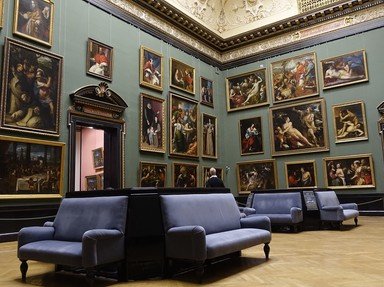Quiz Answer Key and Fun Facts
1. We begin with a truly iconic work, "Starry Night Over the Rhône" painted in 1888. Known for his landscapes, still lifes and portraits (including many of himself), this artist is one of the most influential figures in the history of Western Art. Who is this artist?
2. Painted in 1849-50, "A Burial At Ornans" bought instant fame to the artist. Rejecting the Romanticism that was all the rage at the time, he became one of the most important figures in the Realism movement that would dominate French painting in the middle of the 19th century. Who is this artist?
3. Dating to 1894-95, "The Card Players" that hangs in the Musée d'Orsay is the fifth and final version in the series. Known for using a series of short brushstrokes to build a complex field of colours, he was a leading member of the Post-Impressionists
4. Painted in 1869, our next featured work is "Bathers on the Beach at Trouville" by one of the first French landscape artists who worked outdoors. Known for his pastels, he was dubbed "King of the Skies" because of his low horizons, but he is most notably remembered for his seascapes and shoreline works. Who is this artist?
5. The large (82"x104") 1862-63 oil on canvas "The Luncheon on the Grass" sparked public notoriety and controversy when it was first displayed, at the 1863 Paris Salon. This was an early work by an artist who would be pivotal in the transition from Realism to Impressionism in the latter part of the 19th century. Who is this artist?
6. "The Buddha", painted in 1904, is by a French Symbolist artist whose early works were notable for their dark, fantastical figures. By the time of his death in 1916, he was acknowledged as one of the leading abstract painters of the early 20th century. Who is this artist?
7. Painted in 1883, "Dance in the Country" is a large work depicting a life-size couple in a Post-Impressionist style, although the artist is still considered one of the leading exponents of that school. The woman in this painting is Aline Charigot, who later became the artist's wife. Who is this artist?
8. It is impossible to summarize the collection at the Musee d'Orsay without including a work by perhaps the most-iconic of all French artists. "Study of a Figure Outdoors: Woman with a Parasol, facing left" was painted in 1886 and is typical of both the artist and the Impressionist genre as a whole. Who is this artist?
9. Dating to 1891, "The Circus" is a stunning work by a Parisian Post-Impressionist renowned as the creator of chromoluminarism and pointillism. His 1886 painting, "A Sunday Afternoon on the Island of La Grande Jatte" heralded the beginning of what became as Neo-Impressionism. Who is this artist?
10. Painted in 1871 and given the strange name of "Arrangement in Grey and Black No.1", this is one of the truly iconic artworks of the 19th-century, and has been dubbed "The Victorian Mona Lisa". Although the American-born artist lived mostly in England, he is still considered one of the most important artists of the American Gilded Age. Who is this artist?
Source: Author
EnglishJedi
This quiz was reviewed by FunTrivia editor
ponycargirl before going online.
Any errors found in FunTrivia content are routinely corrected through our feedback system.

